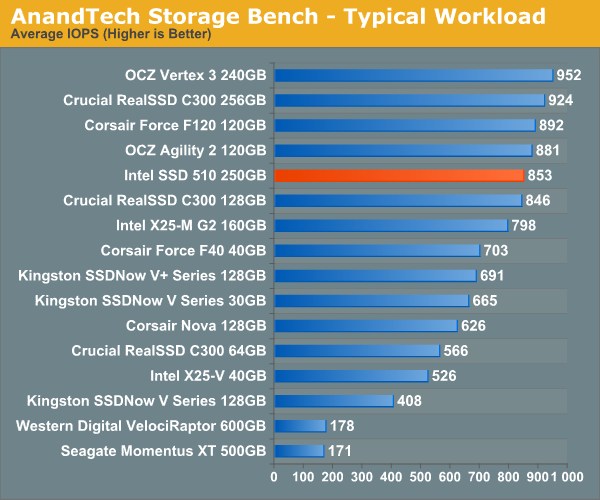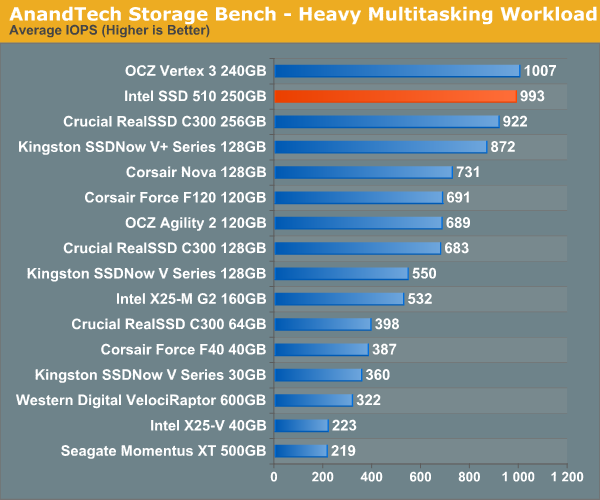The Intel SSD 510 Review
by Anand Lal Shimpi on March 2, 2011 1:23 AM EST- Posted in
- IT Computing
- Storage
- SSDs
- Intel
- Intel SSD 510
AnandTech Storage Bench 2010
To keep things consistent we've also included our older Storage Bench. Note that the old storage test system doesn't have a SATA 6Gbps controller, so we only have one result for the 6Gbps drives.
The first in our benchmark suite is a light/typical usage case. The Windows 7 system is loaded with Firefox, Office 2007 and Adobe Reader among other applications. With Firefox we browse web pages like Facebook, AnandTech, Digg and other sites. Outlook is also running and we use it to check emails, create and send a message with a PDF attachment. Adobe Reader is used to view some PDFs. Excel 2007 is used to create a spreadsheet, graphs and save the document. The same goes for Word 2007. We open and step through a presentation in PowerPoint 2007 received as an email attachment before saving it to the desktop. Finally we watch a bit of a Firefly episode in Windows Media Player 11.
There’s some level of multitasking going on here but it’s not unreasonable by any means. Generally the application tasks proceed linearly, with the exception of things like web browsing which may happen in between one of the other tasks.
The recording is played back on all of our drives here today. Remember that we’re isolating disk performance, all we’re doing is playing back every single disk access that happened in that ~5 minute period of usage. The light workload is composed of 37,501 reads and 20,268 writes. Over 30% of the IOs are 4KB, 11% are 16KB, 22% are 32KB and approximately 13% are 64KB in size. Less than 30% of the operations are absolutely sequential in nature. Average queue depth is 6.09 IOs.
The performance results are reported in average I/O Operations per Second (IOPS):

If there’s a light usage case there’s bound to be a heavy one. In this test we have Microsoft Security Essentials running in the background with real time virus scanning enabled. We also perform a quick scan in the middle of the test. Firefox, Outlook, Excel, Word and Powerpoint are all used the same as they were in the light test. We add Photoshop CS4 to the mix, opening a bunch of 12MP images, editing them, then saving them as highly compressed JPGs for web publishing. Windows 7’s picture viewer is used to view a bunch of pictures on the hard drive. We use 7-zip to create and extract .7z archives. Downloading is also prominently featured in our heavy test; we download large files from the Internet during portions of the benchmark, as well as use uTorrent to grab a couple of torrents. Some of the applications in use are installed during the benchmark, Windows updates are also installed. Towards the end of the test we launch World of Warcraft, play for a few minutes, then delete the folder. This test also takes into account all of the disk accesses that happen while the OS is booting.
The benchmark is 22 minutes long and it consists of 128,895 read operations and 72,411 write operations. Roughly 44% of all IOs were sequential. Approximately 30% of all accesses were 4KB in size, 12% were 16KB in size, 14% were 32KB and 20% were 64KB. Average queue depth was 3.59.

The gaming workload is made up of 75,206 read operations and only 4,592 write operations. Only 20% of the accesses are 4KB in size, nearly 40% are 64KB and 20% are 32KB. A whopping 69% of the IOs are sequential, meaning this is predominantly a sequential read benchmark. The average queue depth is 7.76 IOs.











128 Comments
View All Comments
TrackSmart - Wednesday, March 2, 2011 - link
It would be silly to return the Vertex 2 (my opinion). Just check out the PCMark Vantage scores in this article. There's little real world difference between all of the high end drives. Without the benchmarks, there's no way to tell the drives apart.But if it's going to eat you up inside, knowing you were just a 2-3 months away from having the latest model, go ahead. I'll be keeping be enjoying my OCZ Agility 2 in the mean time.
JohnBooty - Wednesday, March 2, 2011 - link
"I'm wondering if I should return the [Vertex 2] and just wait for the Vertex 3"I've got a mix of Vertex 1's, Intel G1s, Intel G2, and Vertex 2's in a variety of machines at home and at work.
For workstation usage as a software dev, there's not a heck of a lot of subjective (ie, "it feels faster") difference between them. At this level of disk performance, your machine just isn't waiting on the hard drive very often.
Obviously you may have specific needs. I used to work for a client who had a 8GB database that I was constantly backing up and restoring many times a day in the course of development work. Now there was a situation where raw read/write speeds were king and the Vertex 3 probably would have performed close to 2x faster. For me that kind of usage is the exception and not the rule though.
sean.crees - Wednesday, March 2, 2011 - link
I didn't see any discussion on internal garbage collection (ie: NOT trim).Does it have any?
In my mind, this will be the key deciding feature between Intel and Vertex 3. Whichever has the better garbage collection without TRIM. Remember, TRIM still doesn't work in a RAID array or in OSX.
MrCromulent - Wednesday, March 2, 2011 - link
+1. I'm really eager for an IGC comparison of the Intel 510, the Vertex 3 and if possible, also of a current firmware version of the Crucial C300 (since the drive still competes very well).In Anand's initial test, the C300 suffered from very poor IGC, but Marvell supposedly alleviated this problem in their new firmware releases. Unfortunately, no IGC tests have been conducted with the 0006 firmware yet.
halcyon - Wednesday, March 2, 2011 - link
Hate to do this, but+1.
It's not what's the latest, but what's offers the best bang for buck after upgrades.
Such a review would be immensely helpful.
Although based on the Intel 510 TRIM-test random write results, it may have to wait for the first Intel FW upgrade as the numbers with the shipping FW are truly appalling.
Syan48306 - Saturday, March 5, 2011 - link
I'm dying to know how it will hold up in my macbook pro. I finally caved and bought one of these 510 SSD's and although it's after the fact, I still want to know how long it'll still be "good" in my system.tim851 - Wednesday, March 2, 2011 - link
If the original X25-M "conroe'd" the market, it seems G3 "atomed" it. In the way that Intel, in their crusade to maximize profits and segmentize the market, designed quite a bit to conservatively.I'm all for it though, because I believe that currently, the last thing SSDs are lacking is speed, so the last thing they really need is more of it. I believe at this point just about everybody would want one, if it weren't for the prohibitively high prices. So if Intel can half the per-GB-price of the G3, I'll buy one for sure!
anactoraaron - Wednesday, March 2, 2011 - link
+1I thought the exact same thing about the 1st gen drive compared to this one. What makes SSD's "feel" so much faster is the random read/write performance. When the 40GB X25-V is so close to matching random read/write the 510 will just "feel" slow, especially once you have everything installed on it. I mean, really, who cares about sequential performance once you have everything on the drive that you planned putting on it?
Anand, please put the current WD velociraptor numbers into this graph. It will demonstrate what I mean.
Glad I didn't wait and got my 60GB Vertex 2...
anactoraaron - Wednesday, March 2, 2011 - link
oh yeah if I just looked I would see the velociraptor numbers... lol its late and I should be asleep... maybe I am? Did Intel just atom their next SSD?Golgatha - Wednesday, March 2, 2011 - link
I think this is a fair criticism. I also only look at the random R/W performance of these new SSDs. I can pull 215 MB/s R/W from my 300GB Velociraptors in RAID0, and use these drives to install all my games on since game loading performance is largely determined by sequential reading of data from the disks (lots of big sequential files), and because I need around 400GB of space currently for all my game installs .Sequential reads for most SSDs are lower than the 215 MB/s reads I enjoy from my Velociraptors in RAID0. I have a Crucial C300 256MB in this same desktop and I also use an 80GB Intel G2 in my laptop; both of these drives are slower than my Velociraptors in RAID0 in terms of sequential read performance. Also, there is obviously a space concern, in that there isn't enough space on either of these drives to install my games to them.
Now for the host OS and all the random programs I run in parallel, a SSD gives you huge gains and the system just feels snappier. This is largely due to random R/W performance. Basically you'd be hard pressed to tell the difference between sequentially reading 10MB of data or less at 215MB/s (Velociraptors in RAID0) vs 320MB/s (my Crucial C300 256MB average speed on a PCIe4x, SATA3, ASUS add-in card), hence the reason that sequential performance of SSDs doesn't matter much to me anymore.
Now if I could get a 512GB or bigger SSD with greater than 215MB/s sequential read performance for less than $1/GB, I might bite on that. So far this product has not come to market, so I'll stick with my Velociraptors until it does.